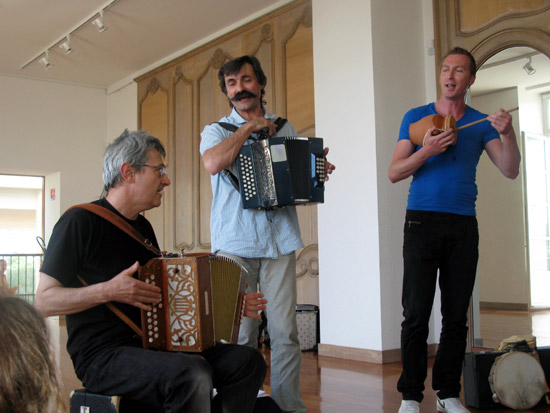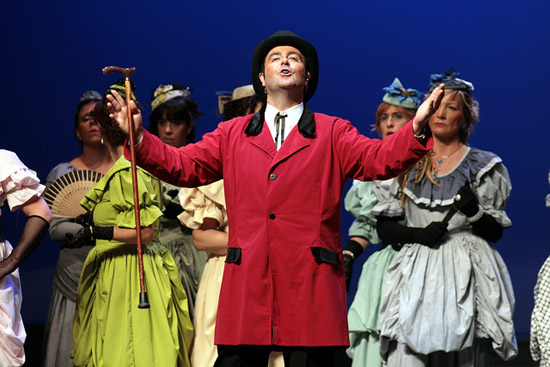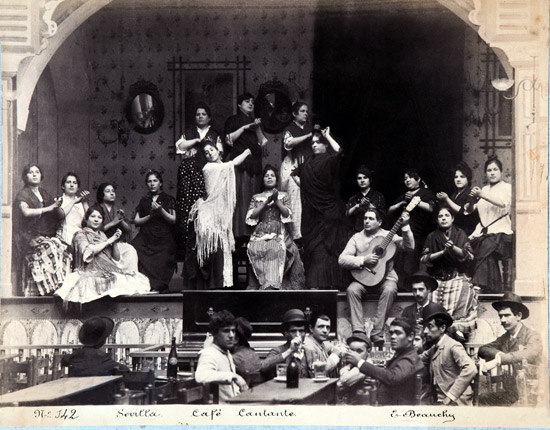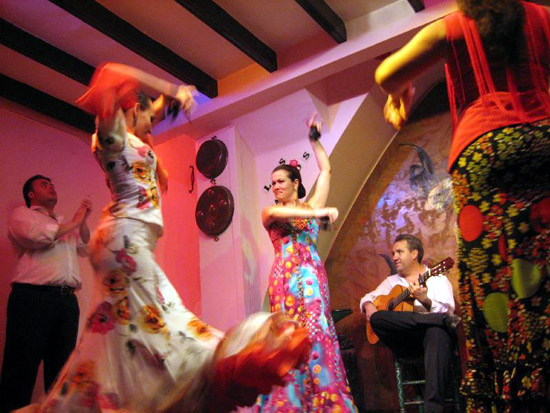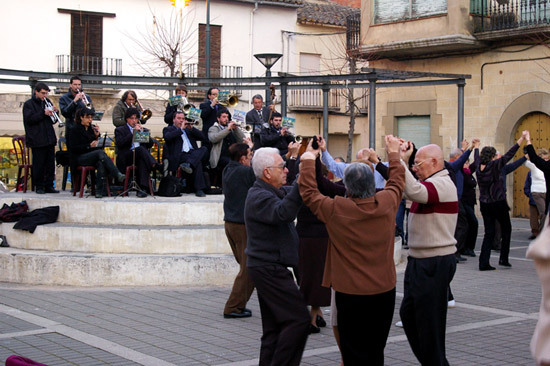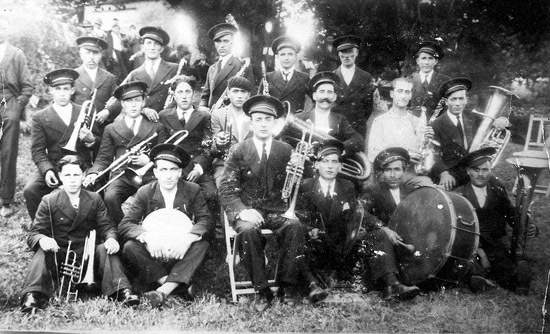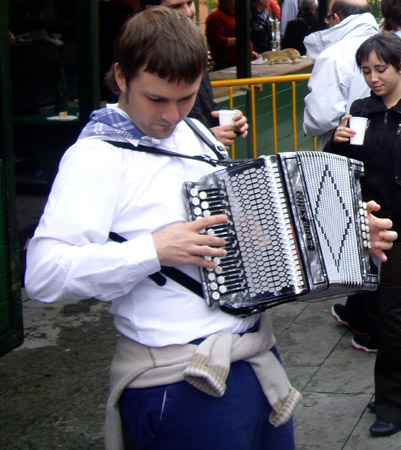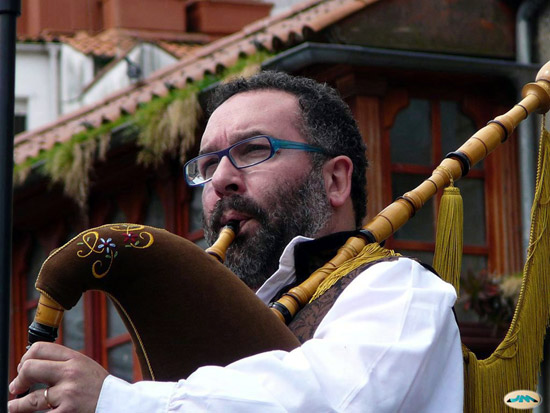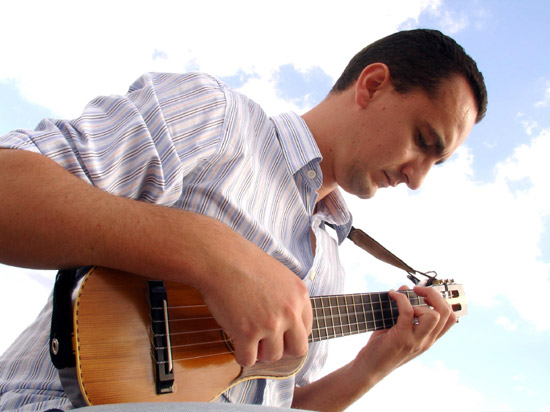Music: Traditional Forms
The Mozarabic Chant
Mozarab refers to Christians in the Spanish region who lived under Arabic rule during al-Andalus; the Mozarabic chant is the liturgical plainchant of those Christians. Little is known about it aside from it being monophonic and sung a cappella, and that it contains four categories: in musicological vocabulary, the chants classed as recitation are those with melodic lines characterized by a simple reciting tone; syllabic chants have lines with one note per syllable; neumatic chants have two to three notes per syllable; and melismatic chants feature melismas—long runs of notes across a single syllable of text.
Mozarabic chants can also be antiphonal—characterized by partial choruses alternately singing verses—or responsorial, which alternate between a soloist singing the verse and the chorus singing the refrain. The Mozarabic chant uses between four and seven modes, and often lacks musical notation.
Occitan Romance
The origins of the troubadours and troubaritz (female troubadours) of Occitania (which covers southern France, parts of Italy, and parts of Catalunya in northern Spain) are unknown. Their history, however, reaches back to the High Middle Ages, during which time they composed and performed lyrical poetry in the Occitan language, often about chivalry and courtly love.
While often metaphysical and intellectual, these Occitan songs were also often funny and vulgar. There were three styles of song: trobar leu, which was formulaic, fun, and accessible to all; trobar ric, characterized by rich poetry; and troubar clus, which was complex and exclusive, being reserved for specific audiences. Trobar leu was the most widespread. These songs were usually monophonic and could fall under one of many fluid genres including morning songs, crusade songs, laments, sonnets, and more.
Another group of troubadours practiced an art known as trobadorismo—the Galician-Portuguese secular lyric. The musical love poems were either voiced by men—called cantiga del amor—or voiced by women—called cantigas del amigo; the mockery songs were called cantigas d’escarnho e de maldizer (songs of mockery and cursing). All cantigas were accompanied by music and included dramatic elements; 420 of them were notated in the 13th-century compendium Cantigas de Santa Maria.
Light Opera
Zarzuela is a dramatic musical form that developed during the 19th century, notably by Barbier, the proclaimed founder of the genre. It includes both musical ensembles and poetic spoken scenes, which can combine to form long operas or comedic one-acts. The former is known as Baroque zarzuela, while the latter is known as Romantic zarzuela. The Romantic form is further divided into the género grande and género chico subgenres.
Birth of the Classical Guitar
Spain is famous for the development of the Spanish guitar—otherwise known as the classical guitar. This instrument, the predecessor of modern acoustic guitars, developed over the centuries from Romantic-period guitars. The design of the modern classical guitar is credited to Antonio Torres, an innovative luthier of the late 19th century, who worked in Sevilla and Almería. Torres pioneered the use of structural fan-bracing for the instrument’s soundboard, which enables a clear, bright, resonant, and balanced tone.
Flamenco
Easily the best-known musical form of Spain, flamenco comprises cante, baile, and toque: singing, dancing, and guitar, respectively. It developed in Andalucían communities with murky and mixed origins—strongly associated with the Roma people and culture, but with strains of Moorish, Greek, and other musical influences as well—and was traditionally improvised. Nowadays this art form is recognized by colorful dress and non-traditional props such as elegant fans and castanets. Flamenco music almost exclusively uses the Greek Dorian (modern Phrygian) mode—also referred to as the “flamenco mode”—and is categorized according to its rhythm in several types known as palos (suits—as in a deck of cards).
Key to the true expression of flamenco is the elusive quality of duende. This is the riveting intensity in a singer’s voice, in a dancer’s emphatic movement, in a guitarist’s passionate virtuosity—it is a feeling that reaches beyond technical facility (but certainly makes use of it) to shake listeners to the core, grabbing hold emotionally and not letting go.
The best performers, who embody duende in their lives as in their music, command intense reverence. For example, when José Monje Cruz, better known as El Camarón de la Isla, died in 1992 (at the early age of 41), the entire country mourned his passing, with more than 100,000 people attending his funeral. Born in Cadiz, El Camarón began his career at a mere 8 years of age, singing at bus stops to earn money. By the time of his passing, he had become known as the greatest flamenco vocalist.
Vocalist La Caita is revered as completely living and embodying duende. Vocalist Diego el Cigala began singing for well-known flamenco dancers at a young age, decades before releasing his first album in the late 1990s. Juan Peña Fernández (El Lebrijano) is a guitar player who eventually became a greatly respected flamenco vocalist as well.
Many flamenco artists also compose, among them guitarist and vocalist Diego Carrasco, guitarist Gerardo Núñez Díaz, and virtuoso guitarist Vicente Amigo. Francisco Sánchez Gómez—better known as Paco de Lucía—from Cadiz, both a guitarist and composer, is considered one of the greatest of his genre and in the world.
José Mercé from Jerez is the nephew of Manuel Soto, the father of Jerez flamenco. Mercé was involved in his first album recording at the age of 13, quickly becoming a vocalist in demand.
José Fernández Torres, also known as Tomatito, is a Spanish Romani flamenco guitarist from Almería. Tomatito was discovered by, and worked with, Paco de Lucía as well as with El Camarón.
Regional and Ethnic Forms
Music of Catalunya
In addition to its troubadour legacy, Catalunya is known for a variety of musical styles. Sardana is a popular dance accompanied by a cobla, a band consisting of wind instruments. Ball de bastons is another dance that is popular in both Catalunya and Aragón. It is traditionally danced to the bagpipes and tabal kettledrum.
Havaneres are sailors’ songs dating back to the 19th-century Spanish involvement with Cuba. Traditionally sung in taverns by male trios, they could be sung a cappella or accompanied by guitar. Rumba catalana is a kind of rumba developed by Romani musicians in Barcelona during the 1950s. This style combines flamenco with Afro-Cuban music, resulting in a new dance. This urban style, however, is often considered an unrefined mongrel form.
Initiated during the Franco period to promote Catalan music, novaçó aimed to make the use of the Catalan language more common and resulted in the development of a new genre of music. Jaume Armengol, Lluís Serrahima, and Miquel Porter formed the group that first began composing songs in Catalan.
Music of Aragón
Jota, a folk dance from Aragón, dates back to the 18th century. The dance is characterized by bouncy movements, traditional costumes, and music accompanied by castanets. The Castilian variation features guitars, bandurrias, lutes, drums, and the double-reed dulzaina, while the Galician variation features bagpipes, the bombo, and other drums.
Music of Castilla
Castilla is home to dances such as the fandango and its own variation of the jota, and is well known for the tradition of the tuna—a serenade by groups of university men who sing to women as a means of collecting money to pay for their tuition. The primary instruments used among these ensembles are the guitar and the tambourine, though the lute and bandurria are also used.
Music of Extremadura
In the Extremadura region near Portugal, the music is characterized by Portuguese influence and a melancholy sound. The zambomba—a friction drum played by pulling on a taut rope inside the body of the drum—is a dominant instrument in the music of this region.
Music of Murcia
The music of Murcia exhibits significant Moorish and Andalucían influence. The region is known for its auroras, songs sung in church accompanied only by the sound of church bells.
Music of Valencia
The music of Valencia has a very Mediterranean sound. Home to many bandes, brass bands that play in even the smallest of towns, the region is also known for its work songs and for “La Muixerenga,” the hymn of Valencia.
Music of the Basque Country
The Basque region, which lies at the border of Spain and France, extending into both countries, has a rich culture, language, and musical tradition all its own. In bertsolaritza, an a cappella form that is closely tied to the challenging Basque language, each bertso consists of a spontaneous verse and a melody, and requires a sharp mind and excellent command of the Basque language. Bertsolaritza is often performed by pairs of bertsolari, who sing alternate verses, though solo and group versions exist as well. Perhaps the definitive Basque vocal tradition, bertsolaritza competitions and festivals keep the practice going strong. There is also a tradition of choral music throughout the Basque region.
Traditional Basque vocals are accompanied by instruments such as the alboka, txalaparta, ttun-ttun, txistu, and kirikoketa. The alboka is a clarinet-type single-reed aerophone made of the horn of a goat, while the txistu or txirula is a Basque fipple flute that has come to symbolize the Basque revival. With only two finger holes and a thumb hole, it can be played with a single-hand, leaving the other hand free to play a percussion instrument—typically a tamboril (tabor drum)—but historically, and currently in eastern Basque Country, also the ttun-ttun, a chordophone that is played by being struck with a stick.
Other Basque percussion instruments include the txalaparta, essentially a wooden plank that is struck with sticks, and the kirikoketa—similar to the txalaparta, this is played by cider-makers who beat the cider press with a striker to create a rhythm. The best-known instrument from the Basque region, though, is the trikitixa, a diatonic button accordion paired with a tambourine for playing an intricate, fast-paced style accompanying vocals.
Music of Galicia
Galicia is known for the gaita gallega, a bagpipe that can be traced back to the Middle Ages. It shares some similarities with Scottish and Irish bagpipes, and exists in two forms: one in which the air bladder is filled by a blowpipe, and a less common variation in which it is filled with a bellows. The Galician gaita has three drones, and is usually part of an ensemble of pipes and drums.
Alalás are the oldest of Galician musical traditions. These chants are arrhythmic, and characterized by a repeating, usually diatonic melody that is based on a continuous drone. Alalás eventually evolved to be polyphonic; they are generally accompanied by bagpipes and percussion.
Music of Mallorca
The traditional music of the Balearic Islands is performed in ensembles known as collas de xeremiers, which consist of flabiol—a small fipple flute with five or six finger holes and three thumb holes (the lowest of which are often plugged with wax to retune the instrument), usually played one-handed—along with the xeremia (Mallorcan bagpipe) and the tamborí drum (usually played simultaneously by the flabiol player). Another ancient instrument found in the Balearics is the reclam de xeremies, a double pipe, each with a single reed and usually four finger holes and one thumbhole.
Music of the Canary Islands
Isas, the best-known folk dances of the Canary Islands, originated from the jota, and are characterized by their happy nature. Also notable throughout the Canary Islands is the timple, a small plucked instrument featuring five strings (though the fifth is sometimes left out to play the instrument like a ukulele). On the island of El Hierro, a flute-and-drum ensemble features the pito herreño, a wooden transverse flute, while in Tenerife, tabor-and-pipe arrangements accompany some dances.
Music of Sephardi Jews
The music of Sephardi Jews was influenced by medieval Spain as well as picking up characteristics of other nations, including Morocco, Turkey, and Greece. This primarily vocal musical form is occasionally accompanied by instruments, most frequently lutes, violins, zithers, and small drums. Since the expulsion of the Jews from Spain in 1492, the musical traditions of the Sephardim have continued in other parts of the Mediterranean world, and lingering influences of their songs remain in Spanish music to this day. Some popular Sephardi music was recorded in the 20th century.
Article written for World Trade Press by Cam Waller.
Copyright © 1993—2025 World Trade Press. All rights reserved.

 Spain
Spain 